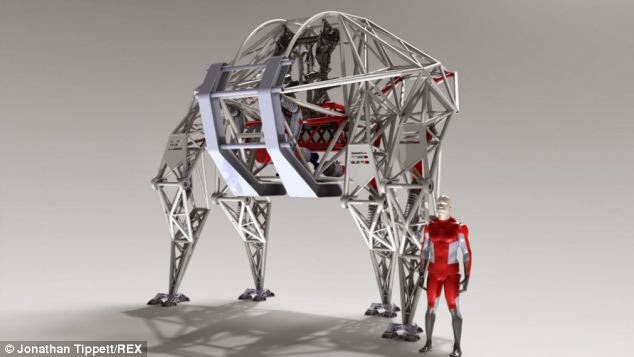Human Robot: 16ft Metal Exoskeleton Will 'Lope Along Like a Gorilla' -Top Speed 19mph
- The 16ft tall ‘anti-robot’ is called Prosthesis and is being built ‘by humans, for humans’ in Vancouver, Canada
- Its performance will be completely dependent on the person strapped into the vast cockpit of the massive metal exoskeleton
- Volunteer
engineers have already built a prototype leg and are raising money on
Indiegogo to fund the creation of the rest of the machine
When it is built, the anti-robot will be a ‘hi-tech racing machine’ but piloting the machine will be difficult for the human inside it and there will be no automated controls.
In effect the creation, which will stand 16ft tall, is like a hefty mechanical suit and has already began being built in a laboratory in Vancouver, Canada.
The volunteers involved in the project said the machine will be the beginning of the ‘anti-robot revolution', will weigh a massive 7,500 lbs (3,400kg) and have a top speed of 19mph (30 kmph).
Jonathan Tippett, the leader of the project, who has previously created a large robotic spider, said: ‘Prosthesis is neither a weapon, nor a tool. It is a sports machine, and the pilot is the athlete. It’s Formula One, meets the future.’
To operate the machine, a pilot will climb into the cockpit of the mechanical quadruped and will be strapped in, GizMag reported. 
The pilot will be able to operate the machine using their arms and legs so that they can become 'at one' with it, which is essential as they will not be able to see the exoskeleton’s feet.
Mr Tippet said Prosthesis will ‘directly follow the movements of the pilots limbs’ so that their arms work the outside legs of the anti-robot and their legs control the machine’s inside legs.
He said: ‘The machine will lope along like a gorilla’ and each huge leg has two joints to move backwards and forwards.
Controlling all of the machine's leg joints requires the pilot to use their entire body and the force of each mechanical foot will be transmitted directly to the pilot’s arms and legs so they can ‘feel’ every step the machine makes.
‘Not violently or ever in a way that could hurt the pilot, but the pilot will know by feel, just exactly how much weight is on each foot at all times,’ Mr Tippet explained. Volunteers involved in the project have already built a 2:3 scale prototype walking leg called Alpha Leg, which uses a complex hydraulics system.
Making the leg has enabled them to refine their plans for a lithium-ion power plant, control system and human control interface, as well as the hydraulics systems themselves.
‘Mastering the Alpha Leg will be the first step in training to become a Prosthesis pilot,’ they said.
Prosthesis is an art research project designed to inspire the next generation of engineers and scientists and so far, over 65 engineering students have contributed to the project over the last three years. ‘We’ve poured hundreds - even thousands - of hours of our time into this project. We're here because we want to be, because we love what we're doing and we want to see our dreams brought to life,’ they wrote on a fundraising page.
The band of volunteers are trying to raise 100,000 Canadian dollars on crowd funding site Indiegogo and are nearing the $30,000 mark.
They claim to have solved ‘all the most challenging engineering problems’ and are keen to making their ambitious anti-robot plans a reality next year, when major backers could become pilots.
The Prosthesis looks reminiscent of the AMPs (Amplified Mobility Platform) as seen in the James Cameron film Avatar AND OTHER SCIENTISTS ARE WORKING ON HI-TECH EXOSKELETONS TOO
U.S. Scientists are working on next-generation combat wear for soldiers inspired by the nano suit worn in the Iron Man films and it could be used two or three years away.
The Tactical Assault Light Operator Suit (Talos) would effectively give its wearer superpowers, such as the ability to see in the dark, super-human strength and a way of deflecting bullets, but its is a work in progress.
The U.S. Special Operations Command (Ussocom) has called on scientists to develop a suit reminiscent of the one seen in the films that uses nanotechnology.
Such a suit would probably build upon work done by an MIT professor who is developing 'liquid armour', which captured the imagination of U.S. armed forces scientists who are looking for a way of protecting their troops from intensive combat situations in Iraq and Afghanistan.
At a conference in May, U.S. Navy Admiral Bill McRaven challenged scientists to build a suit that would function as a 'practical exoskeleton' and protect soldiers from shrapnel and bullets using Kevlar and nanotechnology.
He said that the suit should be light enough for soldiers to wear in battle but also suitable for surveillance missions and the idea has captured people's imaginations.
-DailyMail

